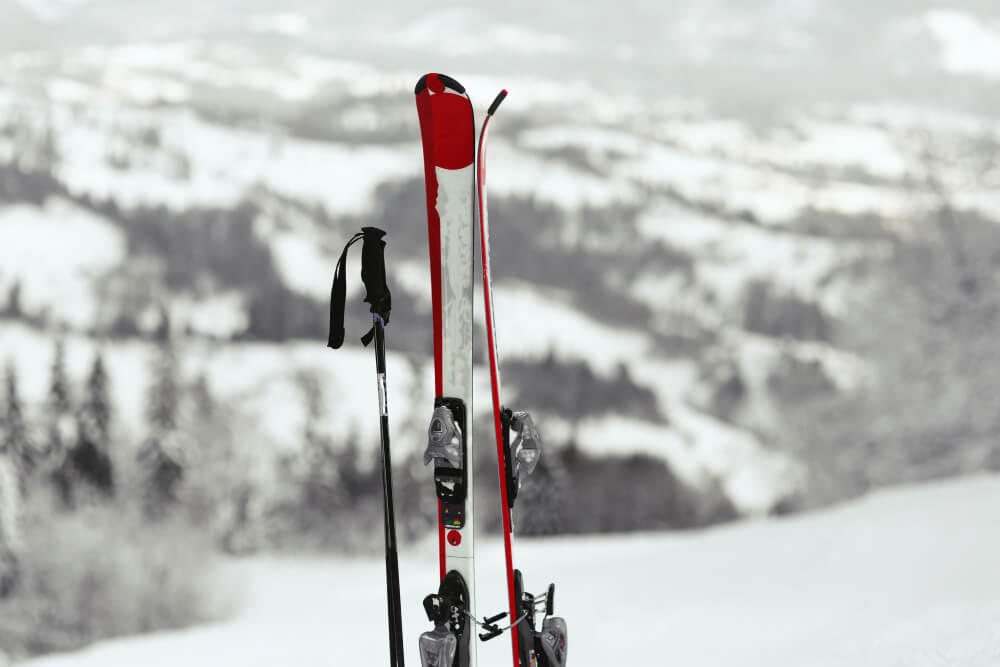Ski Tip Protectors: Why You Need Them & How to Choose the Best Ones

min read

min read
When it comes to protecting your ski gear, most skiers focus on regular waxing, proper storage, and investing in quality ski bags. While these are all essential steps, there’s one simple yet often overlooked accessory that can significantly extend the life of your skis—ski tip protectors.
Ski tips take a lot of abuse, whether from accidental impacts, rough handling during transport, or general wear and tear on the slopes. If you’ve ever noticed chipped, cracked, or frayed ski tips, you know how frustrating—and costly—it can be, especially if you’re using high-performance skis. Damage to the tips not only affects the durability and longevity of your skis but can also impact performance, particularly on hard-packed snow or icy conditions.
That’s where ski tip protectors come in. These small yet effective additions create a protective barrier that helps absorb impacts, reduce wear and tear, and prevent premature damage. Whether you’re an occasional skier or a seasoned pro, investing in the right tip protectors is a smart move that can save you money and help maintain your gear in peak condition.
In this guide, we’ll explore why ski tip protectors are essential, what to look for when choosing the best ones, and some of the top-rated options available today.
Ski tip protectors are small yet essential accessories designed to safeguard the front tips of your skis. Made from durable materials like rubber, plastic, or silicone, these covers fit snugly over the ski tips, acting as a protective barrier against damage.
Their primary function is to:
Although they might seem like a small and optional addition, ski tip protectors play a crucial role in extending the lifespan of your skis. Frequent skiers, in particular, know how quickly ski tips can show signs of wear—especially when transporting them, skiing in rough conditions, or navigating tight spaces like gondolas and lift lines. By investing in quality tip protectors, you’re ensuring that your skis remain in top shape for longer, saving you from costly repairs or replacements down the line.
Many skiers wonder if ski tip protectors are necessary. The answer depends on how often and where you ski, but here are four key reasons to use them:
Ski tips are particularly vulnerable to damage when traveling, storing, or even when skiing over rocks and rough terrain. A small crack or chip can compromise the ski’s integrity, leading to long-term durability issues.
If you’ve spent hundreds (or even thousands) on your skis, you’ll want them to last as long as possible. Ski tip protectors help prevent damage that could force you to replace your skis sooner than expected.
Sharp ski tips can be hazardous, especially when carrying your skis over your shoulder or walking through a crowded lodge. Using tip protectors reduces the risk of injuries to yourself and others.
If you store your skis in a rack or lean them against a wall, tip protectors help reduce movement and prevent scratching against other skis.

There are different types of ski tip protectors, each with its own advantages.
| Type | Material | Best For | Pros | Cons |
|---|---|---|---|---|
| Rubber Tip Protectors | Rubber | All ski types | Flexible, easy to install, absorbs impact well | Can wear out over time |
| Plastic Tip Protectors | Hard plastic | Freeride & racing skis | Durable, offers strong protection | Less flexible, harder to install |
| Silicone Tip Protectors | Silicone | Lightweight skis | Lightweight, great for travel | Less protective against heavy impacts |
| Custom-Fit Tip Protectors | Varies | Specific ski brands | Perfect fit, great durability | More expensive, may not be universal |
The best type depends on your skiing style, budget, and whether you prioritize flexibility or durability.
Before buying ski tip protectors, consider these factors:
Not all tip protectors fit every ski. Check the dimensions and compatibility with your skis before purchasing. Some brands offer universal fit options, while others require specific models.
Most rubber and silicone tip protectors easily slip over the ski tips, while plastic versions may require more effort to install. If you frequently remove and replace them, opt for a flexible design.
Consider where and how often you ski. Freeride and backcountry skiers may need stronger protectors due to rougher conditions, while casual skiers can opt for softer, more flexible models.
Installing ski tip protectors is quick and easy:
Once installed, your skis will be better protected against impact and damage.
If you’re looking for the best ski tip protectors on the market, here are some top recommendations:
✅ Durable rubber design
✅ Universal fit for most skis
✅ Easy to install
✅ Soft silicone for flexibility
✅ Budget-friendly
✅ Ideal for travel and storage
✅ Best for high-impact skiing
✅ Long-lasting protection
✅ Great for freeride skis
✅ Affordable option for beginners
✅ Decent durability
✅ Simple installation
Each of these options offers a balance of durability, fit, and ease of use.
Not necessarily, but they are highly recommended for frequent skiers, travelers, and those who ski in rocky or icy conditions.
No, they are lightweight and designed to protect ski tips without impacting speed or maneuverability.
It depends on usage, but most rubber and silicone protectors last several seasons, while plastic protectors can last even longer.
Most tip protectors are designed for storage and transport only. If you want added protection while skiing, look for impact-resistant versions made for freeride and backcountry skiing.
Ski tip protectors may seem like a small accessory, but they play a significant role in protecting your skis and ensuring their longevity. Whether you’re a casual skier or a professional athlete, investing in quality tip protectors can save you from costly ski repairs.
If you haven’t considered using ski tip protectors before, now is the perfect time to add them to your gear. They’re affordable, easy to install, and can make a big difference in ski maintenance.
❄ Need help choosing the right ski tip protectors? Check out our latest recommendations and find the best option for your skis! 🎿